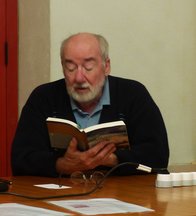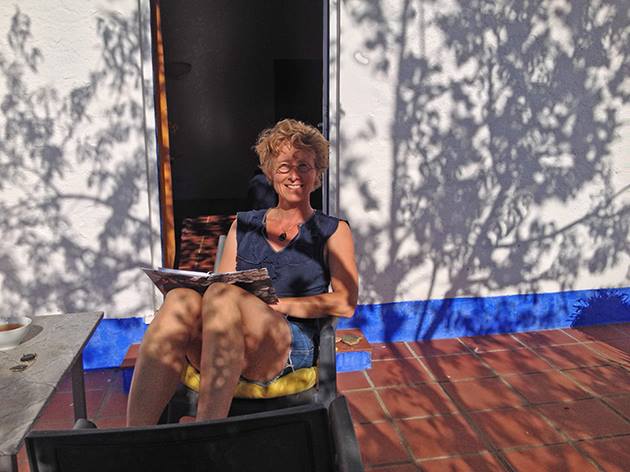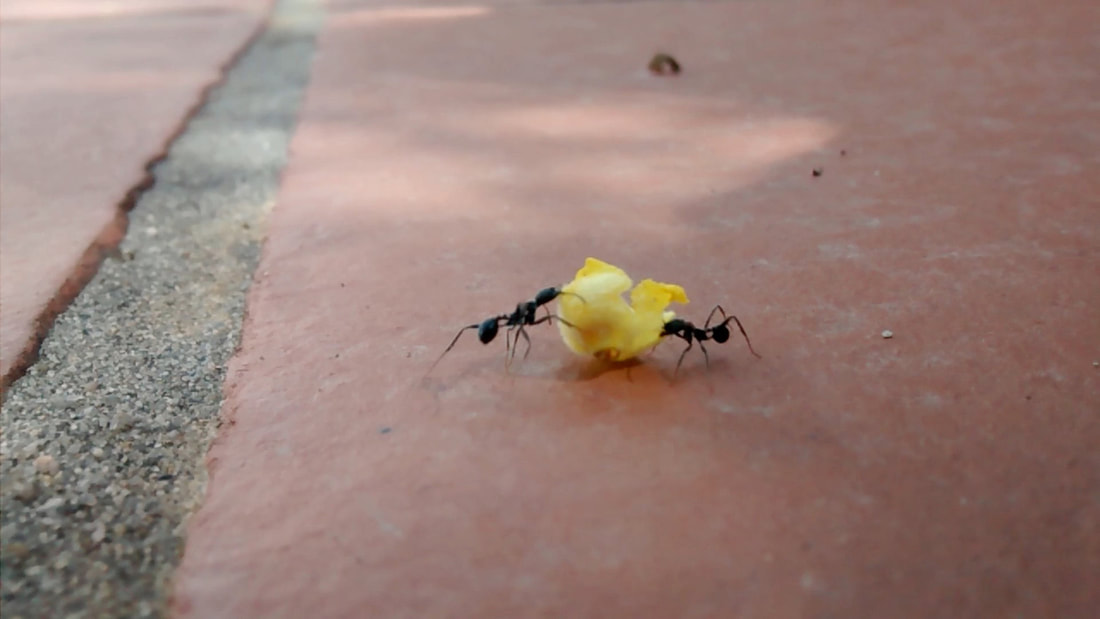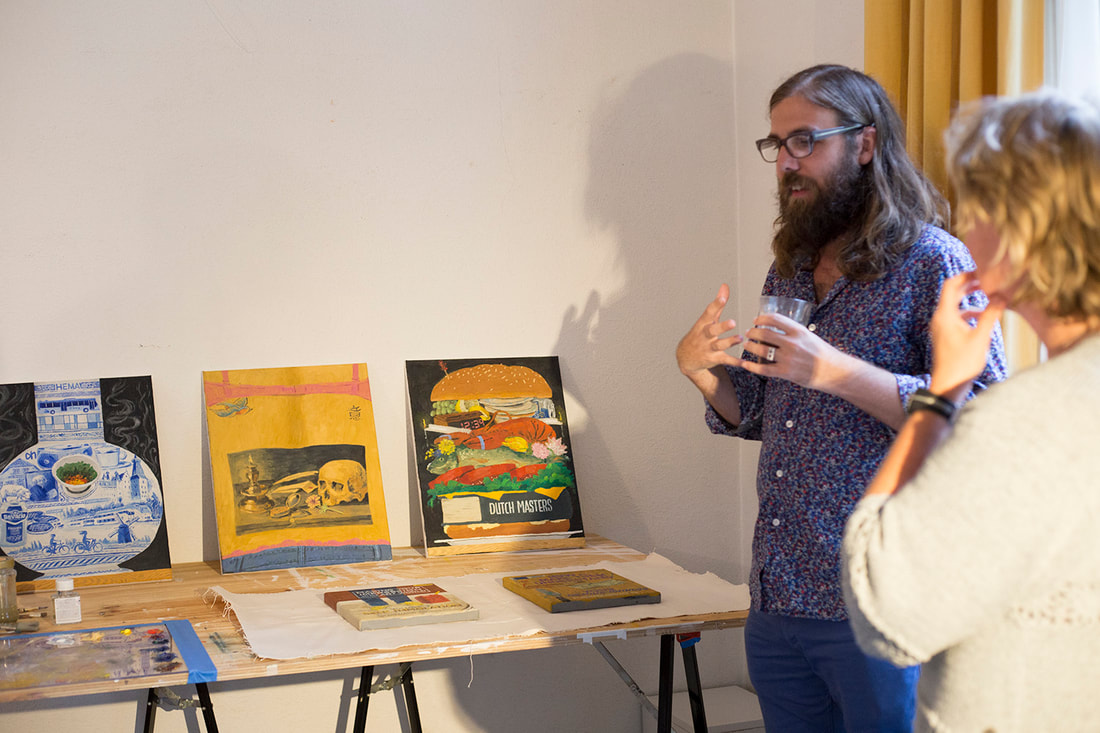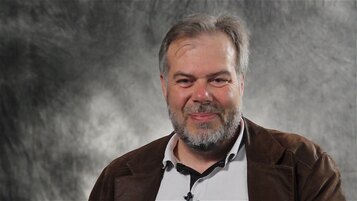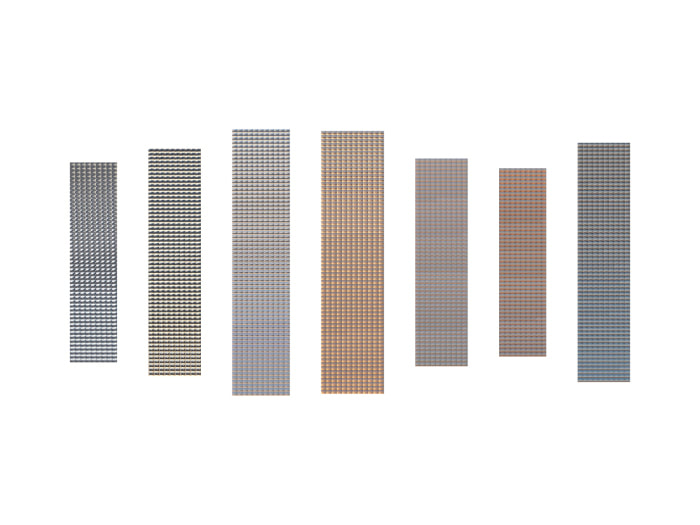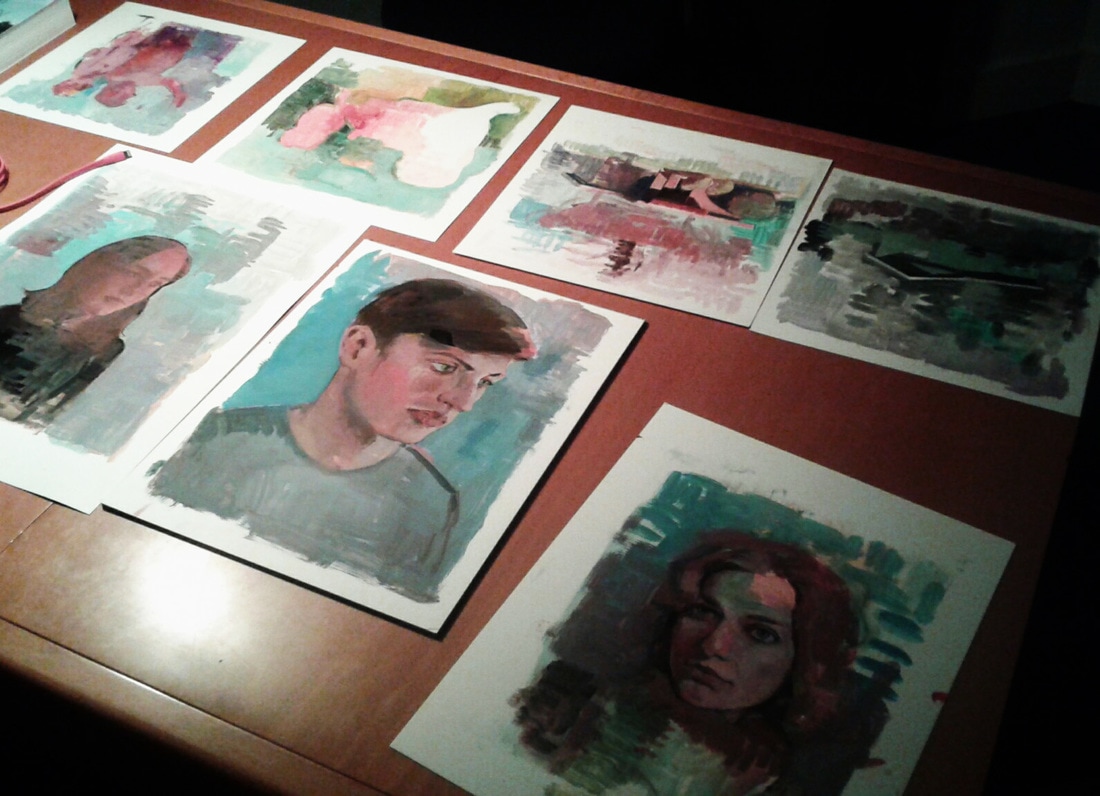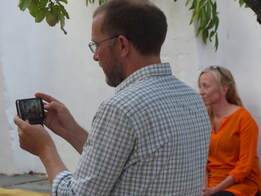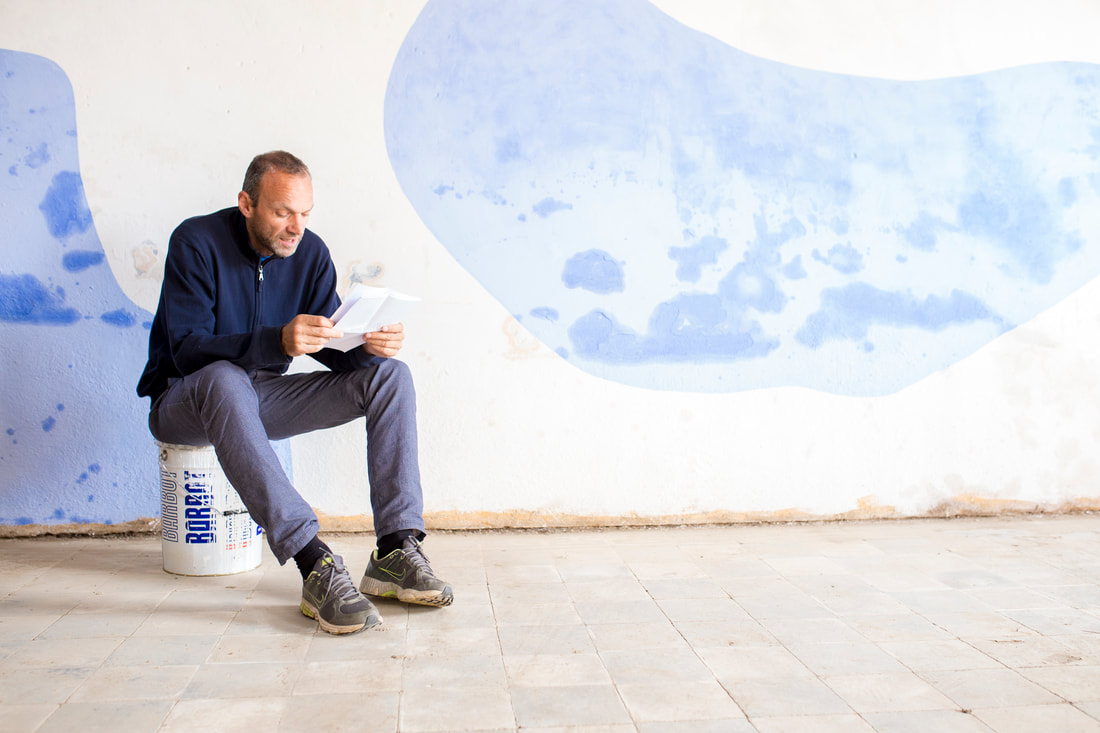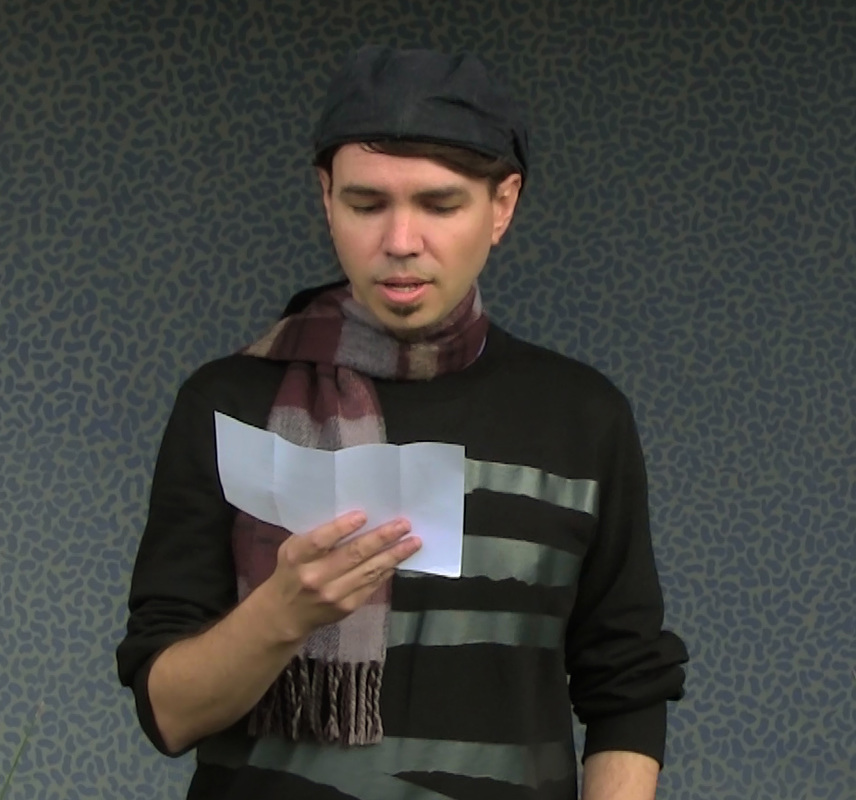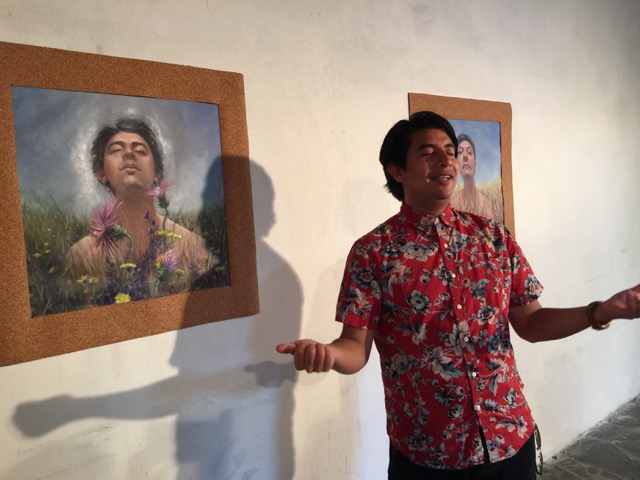Residents 2016
For residents of 2017 see the page 2017. Other pages show residents and their projects in 2015, 2014 , 2012 and 2013 and 2004-2011.
A visual collage of residents is in this slide show.
For residents of 2017 see the page 2017. Other pages show residents and their projects in 2015, 2014 , 2012 and 2013 and 2004-2011.
A visual collage of residents is in this slide show.
|
On 25 June we had an open studio. The slide show above gives an impression. Elsewhere on this page is more info on the artists and their projects.
The Australian artists Ruby Fiedler (multimedia) and Peter Emptage (musician) were two of the last ones in 2016. They choose the ruins of a two-hundred years old watermill as their place of work. They did a gigantic job to uncover it from bushes and soil, creating a place that shows lots of history as well as myths.
Two hundred years ago a miller and his family were living in the valley of a small river. He used the waterpower to grind the grain and the grain to make bread for the locals. Suddenly their peaceful life was shattered by the construction of a railway line almost over their house. Deeply frustrated they left their property, forever. Two hundred years later the railway line was abandoned and Peter and Ruby uncovered what was left from the millers´ house and invited their friends for a walk to the place. It became an homage to rural life and to the miller´s family. Peter and Ruby named their project Don´t Stop Wanting. At the end they invited fellow residents and friends for a site specific happening in the ruins, starting with a musical walk from Monte da Marmeleira. We just published a video compilation. Peter also published audio recordings of his creations on internet. Tom Phelan, an Ireland-born writer living and working in the USA, was working on a memoir, assisted by his editor and partner in life, Patricia Mansfield Phelan. We look forward to reading it because he lived an intriguing life and is a good writer. During his artist talk he read a part of The Canal Bridge, an impressive novel about Irish soldiers who fought in the British army in the First World War. But when returning home, often traumatized, they were sometimes seen as traitors by their fellow villagers and even by their families.
Gerdien Wolthaus Paauw, a Dutch photographer, came to work on a very personal project: a book on her mother who was suffering from a lethal neuro-muscular disease. As a starting point she used notes written by her mother when she lost her speech. Gerdien added images to those notes, taken in the surroundings of her residency, which had an indirect but highly symbolic, metaphoric or emotional relation with the texts. A deeper layer in the book became the mother-daughter relation as influenced by the disease. When she showed her first drafts everybody was deeply impressed.
Cor + Som is the name of an installation by Pat Badt (lightcape) & Scott Sherk (soundscape) in the Castelo de Evoramonte, exhibited in August, September 2016. We made a special page for this beautiful exhibition. See Cor + Som for more information.
Saaya Hitomi (Japan) is a performer and a video artist. She initially intended to do a project that focuses on the work and life of a shepherd. However, the beautiful scenery reminded her a far-off place and brought her project in a wider perspective. It made her think deeply over how we got over a past and what the past can tell us about the future. She produced a video work with both fiction and nonfiction in which the shepherd and a prediction act are important elements.
Nico Huijbregts (Holland) comes back nearly every year. See his temporary page on this site. This year he went for BIG: his largest painting this time was a bit more than 2x5m. Although he kept the stile and motives that he used for his small works (around 10x15cm), the big paintings are lighter, brighter and playful. He gave his new series the title: Free Floating Forms.
Besides painting he also played the piano. He found beautiful collaborations with other artists. One was "Graphic Scores" : improvisations based on the visual art works of other residents: . Carlos Michel Alves gave him a video of an insect floating in the water, António Pliz shows architectural sketches, Catalina Ouyang made an animation with her marble sculptings, Yvonne Halfens showed a a stop motion of moulding clay, Scott Sherk supplied a soundscape of the sea in Maine, Pat Badt brought some painted grass blades, Saaya Hitomi let Nico take a tarot card and Ludger showed a wooden necklace. The improvisations in combination with the graphic scores were more than fascinating. Later that month Nico did improvisations with Hannah Pass and Gerry van der Linden reading her recent work (prose and poems, respectively) and with Elena Chaeh and and Raphaelle Oskar (cello and voice). Uma Estranha no Alentejo was published in May and got its 2nd edition in June. It is a beautiful book with poems by Gerry van der Linden and photos by Luís Branco. On the occasion of the publication an an exhibition with works of the two artists took place in the Public Library of Évora. Quite an honor because the library is a national monument, situated on 50 meters from the Roman Temple of Diana.
Gerry van der Linden (Holland) is first of all poet. During her past two residencies she made beautiful poems using her observations of life in Alentejo as a starting point. In addition she made small installations with a touch of humour and surrealism. Luís Branco (Portugal) is press photographer with a passion for art. He made arty photos of Gerry´s installations. Some poems, installations and photos were exhibited. In combination with this exhibition we found sufficient support to publish a book with the works of Gerry and Luís. The publisher: Caminho das Palavras, put so much effort in the design that it is becoming a piece of art in itself. As can be seen in the slides show on this page the opening of the exhibition and book presentation was a special event for many reasons. We got a performance by Puppeteer Manuel Manuel Dias, accompanied by Sabine Harrer on violin. Gerry showed newly made installations and Luis Branco showed four photos, all on projects of residents of 2015 (see slide show):
Appart from having an exhibition Gerry was also working on a novella in which she tells about her contacts in the 1980th with Iosif Brodsky. In between she wrote poems with subtle irony on the mirror in her room, on a tray with left overs and on several other daily life observations.
Iris Haeck (Holland) was a resident in Portugal in 2010, where she did the finishing touch of a novel focusing on spiritual experiences: De Dageraadvanger. This time she choose for OBRAS-Holland to do another finishing touch: on a children’s book. She also was working on another novel for which she found inspiration in the nature around her residence.
In 2014 Addoley Dzegede (USA) made a short video clip: as loucas, on the ants on her terrace: moving loads, giving signals, helping to each other and fighting. Nothing special but highly in the same time, may be because this micro world is full of similarities with human civilization. In 2016 the video was first selected for a short-film festival in Chicago, later for Video Art Festival, Now & After ’16, in Moscow, Russia at the State Darwin Museum. And most recenty for In Deep Ecology, curated by Marina Fomenko, at Tenerife Espacio de las Artes, in Tenerife, Spain. Congratulations Addoley!
Uma Estranha no Alentejo was published in May and got its 2nd edition in June. It is a beautiful book with poems by Gerry van der Linden and photos by Luís Branco. On the occasion of the publication an an exhibition with works of the two artists took place in the Public Library of Évora. Quite an honor because the library is a national monument, situated on 50 meters from the Roman Temple of Diana.
Gerry van der Linden (Holland) is first of all poet. During her past two residencies she made beautiful poems using her observations of life in Alentejo as a starting point. In addition she made small installations with a touch of humour and surrealism. Luís Branco (Portugal) is press photographer with a passion for art. He made arty photos of Gerry´s installations. Some poems, installations and photos were exhibited. In combination with this exhibition we found sufficient support to publish a book with the works of Gerry and Luís. The publisher: Caminho das Palavras, put so much effort in the design that it is becoming a piece of art in itself. As can be seen in the slides show on this page the opening of the exhibition and book presentation was a special event for many reasons. We got a performance by Puppeteer Manuel Manuel Dias, accompanied by Sabine Harrer on violin. Gerry showed newly made installations and Luis Branco showed four photos, all on projects of residents of 2015 (see slide show):
Maureen Drennan (USA) was having a residency at OBRAS Holland. She made a photo documentary on Syrian Refugees in Holland. She heard their stories first hand: their leaving home and family and then living in a strange land. It became a very personal portrait: that they experienced a catastrophe is only one aspect of what defines them. Maureen showed their vulnerability but also their resilience. A selection of images is on Instagram.
Paul Gagner (USA) also had a residency at OBRAS Holland. He made intriguing paintings with lots of sweet irony based on his observations: he mixed, for instance, Dutch cultural traditions (such as Delfs Blue ceramics) with the current daily life (such as fatty hamburgers).
Tricia van Oostveen (Canada) also had a residency in Holland. She was mainly painting on series that focuses on climate change. She tries to create “sublime and emotional paintings”. But she also took another theme: as her ancestors are Dutch and Canadian she was trying to combine references to Hobbema and Carmichael into one landscape.
Roland van Oostveen (Canada) had a very intense 6-weeks residency in Holland. He worked on his scientific articles on the use of technology in education, on a model for online learning communities, and on more than a handful of others. And he visited colleagues in Nijmegen, Twente and Potsdam. And luckily enough he found time to explore the surroundings of Renkum, which became a highlight in his residency.
Evelyne Hendrikx (Holland) is photographer, but her work also reminds to geometrical abstractionism of the 1950th. The makes hundreds of photos of the same landscape element and arranges them in a grid of some 50x50 cm. It results in horizontal and vertical lines; the original subject gets nearly invisible and a study in harmony appears. At OBRAS Eveline choose for marble quarries and for waving grass as her starting points.
Annemie Bogaerts came to explore, together with Peter de Koning, the possibilities to make floor mosaics with charcoal and marble dust in Convento Flor de Rosa in Crato. Also Annemie has a track record in Portugal. She made Deambular: an impressive floor installation showing a labyrinth, in the fortress of Evoramonte (2012) and as a kind of try out Borda land and several more several beautiful floor mosaics on the Herdade da Marmeleira (2011). During her residency this year Annemie experimented with found objects covered with ash (see image).
|
András Kecskes (mixed media; Hungary) combined landscape elements in solid, often geometrical forms landscape with playfulness. He suggested a house to be floating in the air by using the same blue for both the plinth of the house and the sky and he painted a cork surface on a marble block. This and much more was in his end-presentation. It was an impressive show of both his artistic skills and his good mood.
Gregory Eltringham (USA) had a short, but very productive residency in Holland. He made some twenty paintings, mostly half abstract portraiture, often with a touch of irony. He uses a very personal style and colour spectrum, but most unique is the way he applies paint and paper: while from a distance the paint strokes look pasty, they are in fact extremely flat: he flattens the paint until no elevation is left and he uses a sort of glossy photographical paper to paint on.
As a side activity he cycled some 500 kms, giving him inspiration and a good physical condition, but also, in his words, the strength and resistance to return to the land of Trump. Clara de Mik (percusionist) and Lenneke van der Goot (visual artist with a speciality in drawing) used OBRAS Holland in the first place as a homebase for activities in the region. Clara had four concerts and Lenneke an exposition. But Lenneke also found time and inspiration to start up a new series of drawings.
Stella Walley (UK) came to make a “flying carpet”. After several tests she decided to apply slabs of cork. She placed them on iron rods on a slope next to the house. She placed the carpet with a gentle curve that seems to direct to the mountain of Evoramonte. This hints to the observation, done recently (see lower in this newsletter), that a nearby prehistoric grave has a portal that is exactly pointing towards the mountain of Evoramonte. This can be coincidence, but could also mean that in those times it was a holy mountain.
Stella was highly productive. She was experimenting with lots of materials and techniques, including marble. She was especially intrigued by its transparency when sliced thinly. Although she had a big studio, at her end-presentation it was more than full with all kinds of work of generally highly artistic value. The prophet of Seville is a work of Musical Theatre that was created by Elena Cheah and Raphaelle Oskar in their residency last year. This year they did the finishing touch and performed in the Igreja de São Vicente in Evora. They attracted an amazing lot of audience (much more than there were chairs) and it was generally highly appreciated.
The piece is about a boy who discovers that his parents are hiding a secret of existential level for both the parents and him: they live as a Christian family, but his parents are in fact Jewish and Muslim. He becomes desperate by the notion that his world is fake. The piece has several layers. The first is about multi-culturalism and a deeper layer is a criticism on the current spirit in the Western world: that you must be and must feel special. Raphaelle Oskar plays a young boy with flamboyance, humor, big gestures and sometimes aggression. Elena Cheah takes the contemplative parts by playing the cello and reading poetic, introvert texts. Click here to see a trailer. Elena Cheah (USA, living in Germany) is cellist, both soloist and principal cellist in orchestras (such as Metropolitan Opera Orchestra, Deutsche Oper and Staatskapelle Berlin). She combines her classical career with a rock band, film music, jazz and tango. She teaches in several countries and writes. This year has been refining some prose poetry and was working on a collection of stories around family themes that may become a novel. For the open studio, she accompanied herself on the cello while reading some written works. This was surely one of the highlights of that open studio. Raphaelle Oskar (Croatia, also living in Germany) has a philosophy and linguistics degree and a singers education As an actress she has performed in the USA, Gemany and Croatia. At OBRAS she worked in the scope of her history study on a thesis on Ancient Roman Catacombs and she started writing a new theatre piece. Yvonne Halfens (Holland) made ceramic works with clay from the region and the oven of the Sisters Flor from Estremoz. She generally made heads with some elements of abstraction. She states herself: “the human figure is a very classical and old theme in art. I try to find my own interpretation, based on the time we are living in and my own experiences, but also not ignoring the classics and all that is already done. The heads I'm making now are no portraits, they don't resemble anyone but reflect on what it is to be a human.”.
The work and ideas of Yvonne are that intriguing, that we suggested her to come up with a proposal for an exhibition in 2018. The first brainstorms resulted already in a promising base. Janet Griffiths (UK) was inspired in particular by the myriad of colors and forms of the wild flowers. She has been developing a painterly hand-printing technique using local marble to paint on. Her research at OBRAS was part of a greater project at home: it is into bees. The resulting art work is about making food and forage for the bees.
Erika Dahlen, visual artist form Sweden, was experimenting with felt that she soaked in paint. After drying it sometimes spontaneously resulted in half-abstract landscapes or human figures. To her own surprise, while she is increasingly worried about the state of mankind and environment, her art work get more romantic and playful. See the slide show for an impression of her end presentation.
Erika is an annual visitor. In 2014 she had a grand solo-exhibition in the Palacio de Dom Manuel in Évora. Henrik Sjöberg (Sweden) is publisher by profession. But he is also working on a thesis to obtain a university degree in philosophy. During his artist talk he impressed all with an essay on intrinsic values, with two examples: do “friendship” and “Science” have intrinsic value. The discussion continued during the shared dinner and once in a while the days after, even sometimes in the swimming pool.
Elma van Haren (Holland) was working on a new poetry book (scheduled to be ready in spring 2017). She decided that the Alentejo landscape will play a prominent role in it. Elma creates poems as a sculptor. What she feels comes from what she sees: she always works with ‘real’ images.
Regan Halas (USA) showed her multi talent. She did write and sing her own songs, played the cello, made collages and small installations, created soundscapes and did some acting. Common denominators were sensitivity, harmony and some dreaminess. One of her fascinations was “time”. She deeply impressed all visitors during the happening in the train station (see Bart Drost).
Tim Pettit (USA) is an emerging percussionist and highly talented sound artist. He collected sounds and made intriguing compositions. A new discovery for him was our “Cajon”, a typical Spanish percussion instrument. He explored and exploited all that could be made with it and made some nearly-studio-quality recordings as part of a new sound installation.
At OBRAS-Holland Mieke Eerkens (USA) was writing a novel, in which her grandparents are figuring: they were living in Holland during the Second World War. Mieke was visiting places with a link to that time and was interviewing elderly people in the direct surroundings of her residency. Many proved to have still a vivid memory to that period.
Also in OBRAS-Holland Leif Landen (Sweden) was working on a book with Romantism being the central theme. It introduces some authors and artists, mostly from the former half of the 19th centuary. For this he was visiting Dutch museums and archives.
Josef Kleindienst (Austria) did work on the finishing touch of his third novel. He also found time write a short theatre piece, especially for the event at the abandoned train station of Evoramonte on 24 May. It was brought to stage by Regan Halas and Bart Drost.
Kris Williamson (Malaysia) was working on his third novel. Some of his earlier work was adapted to movies and a radio play.
While working on his novel he found time to write thirteen short stories ("Alentejo shorts") and four poems ("ugly poems") on his impressions and observations. All were full of irony and humor. On 25 June we had an Open Studio for Janet Griffiths (UK), Aurélie Dubois (Canada), Diane Richey-Ward (USA), John Galan (USA) and Elma van Haren (Holland). There were also contributions from Ingrid Simons (Holland), Tim Petitt (USA), Regan Halas (USA) and Kris Williamson (Malaysia). See a slide show on this page.
In her art work Eeva Liisa Puhakka (Finland) is investigating the role of smell in experiencing the environment. For this she distilled plants in her surroundings. Her fellow residents were invited to do a test (see slide show). For this she selected spearmint (Mentha spicata), wild oat (Avena sterilis), wild fennel (Foeniculum vulgare), Peppercorn tree (Schinus molle), stone rose (Cistus ladanifer), white clover (Trifolium repens) and French lavender (Lavandula stoechas). All were exited but were also surprised how difficult it is to define or recognize a smell, even although everybody has clear smell related memories.
Gaelle Pelachoud (France) makes artist books, mostly on subjects related to nature or culture. Her books are fascinating because of their content, but are treasures because of their forms: three-dimensional installations, rather than books, but still inviting to take them in your hands. At OBRAS she made hundreds of aquarelle drawings of two storks making a nest and a family. She continued working on it in Paris, but her publisher has already approved her manuscript. We have scheduled an exhibition for her in the public library in Évora in September 2017.
Since 2010 Erdmute Blach (Germany) comes every year in spring: she can work in a bigger atelier then at home and she got addicted to the Alentejo nature. This time she experimented with abstract black-and-white drawings. They suggests a bit Japanese calligraphies.
Van Pam was doing a research project on religious buildings that have got a secular second life. For this project she visited locations in Belgium, Germany and Holland. At the end of her stay she gave an artist talk that impressed everybody.
|
Linda Buckmaster (USA) made poems inspired by the nature around her residency. Her artist talk was more than impressive: a kind of performance in the patio, on the walls of which she had hung new and older poems and where she created some installations with found objects. She guided us along the works while reciting poems.
A special project during her residency was leaving words in the landscape. Weeks after she left we are still finding these words. Marcel Schellekens (Holland) paints in the tradition of romantic impressionism. His skills of painting shadows under a tree, light shining through a curtain, street view during siesta and so on are astonishing. At OBRAS he painted, among others, a school class sheltering in the shadow of a statue and a still life of giant marble blocks. The slide show gives an impression.
After five residencies in the past five years, Victoria Cattoni returned, for six weeks. But this one was special: she left Singapore where she lived and worked in the past decade (and before in Indonesia) and after her residency she returned to her home country: Australia, to start a new, still largely undefined phase in her life. The last artistic project in Singapore was a grand solo exhibition, with paintings made in Portugal, entitled “Pinturas”.
Victoria paints with intuition but in the same time avoids repeating herself. Each action in the painting should look effortless but was in fact carefully chosen and executed. To achieve this she decided to paint and draw with sticks that she found in the field, making the brush strokes sturdy expressive. As a contrast she added lively, light and aerial patches of colour. The result was in most cases a visual adventure with lots of suggestions and no clues. Carolyn Wenning (USA) came back. She generally paints abstract with a vague suggestion of something figurative. Whilein 2015 she made paintings in grey tones with the marble quarries as a starting point (see this video), this year she worked very colorful inspired by the light and surrounding nature. And she made small installations with bits of old books that she found on the second-hand market. See the slide show for an impression. By coincidence, due to a shift of residents, she had two artist talks and two studio visits. She impressed everybody in all occasions.
Matias Ringheim (Norway) made compositions with objects found in the marble quarry and at the second market of Estremoz. He also made rubbings with the surfaces of cork and marble and ultra close-up photos of insects. But most fascinating was the combination of embroidery patterns found on the market with slices of marble.
Catalina Ouyang (USA) made videos and worked on marble, even with 40oC. She amazed everybody because of energy, but even more of the originality and artistic quality of her work. As an introduction for her Open Studio she wrote: My work is unavoidably about me; and my body, as femme and non-white, is unavoidably political. So my work explores and responds to my lived experiences as a second-generation, Chinese-American woman. At OBRAS, I have been integrating the process of carving marble with drawings and filmed footage that will ultimately culminate in a video (tentatively) titled The Marble Departure: A Story of Progress. I am thinking about marble, this classical sculptural material, and the weight of its male history in the Western canon; in connection with the many megalithic structures in this region of Portugal, and their implications of human progress, and what kinds of deep-rooted violence that “progress” has meant throughout history.
Hannah Pass (USA) came to work on her newest novel. It is in futuristic Wisconsin, but basically it is a story of a young woman who hopes to redesign her life to obtain her next big love, in a time spirit where the idea of monogamy is obsolete. She found lots of enchanted ingredients at her residency and wider surroundings to enrich her story. In addition she had several collaborations with other residents, including a reading accompanied by improvisations by Nico Huijbreghts on the piano.
Diane Richey-Ward (USA) was working on a series entitled “Intimate Migration”. This work investigates movement between one place and another: how does one’s journey affect the perception of reality and space? By layering elements of mechanical and natural forms in drawn images overlapped by transparent photo and video projections, she searches for dynamic configurations and mutations. The result is an image that is full of movement and energy in the same time highly mysterious.
John Galan (USA) invokes the portrayal of the human psyche by using the idea that all life forms are connected through an unconscious mind. The paintings produced at OBRAS reflect this theme and were in the same time strongly influenced by the environment, seasons, and culture. In all his portraiture he gave nature a prominent role. Apart from his painting he also did a highly impressive performance.
John has a beautiful artist statement: The brush found my fingertips before I can remember anything else. Every time I paint, I am discovering a new part of me, an extension of myself which I can share with the world. Soon after his return home John got the message that one of his paintings was just featured by the Official Tourism Instagram account "Visit Portugal": quite honorable and good PR for him! Aurélie Dubois (Canada) is interested in the mechanisms of appreciating objects in relation to their potential narrative. She relates kitsch, science and fiction in an attempt to trigger contemplation on environment and human activity. At OBRAS the was working on a series of drawings and installations that represent a fictional time: a mixture of past, present and future through an interpretation of its remains.
Bart Drost (Holland) got deeply inspired by the abandoned train station of Evoramonte, around 10 minutes walking from our house. He is not the first one: some six artists-in-residence preceded him in the past 5 years. But he is certainly the one whose intervention is most uncompromising. He hammered several bricked doors, whitewashed some inner walls and painted them with a serene, abstract pattern.
The railway station was closed for more than 50 years, but Bart re-opened its doors in an attempt to create a space where you can travel in your mind, in your imagination. Each of the six rooms of the building got its own character. Bart invited his fellow residents to take part in a happening on 24 May, 5-6 pm: Jozef Kleindienst (Austria) did read from his book ‘Freifahrt’, Regan Halas (USA) presented a sound installation that includes playing the cell, Ingrid Simons (Holland) showed her video ‘morte do sol’, Kris Williamson (Malaysia) performed "ugly poems" and Tim Pettit (USA) provided electronic and acoustic sound scapes. in addition, in several combinations the artists did improvisations and jam sessions. See a video and a slide show for an impression. The abandoned railway station of Evoramonte can be visited and is easy to find: on the N18 From Evora to Estremoz, 3km after Evoramonte: take the transito local). Ingrid Simons (Holland) choose to analyze the change of seasons in “the hidden Paradise”, a small open place in the middle of a lush oak forest, some 20 minutes from our house. At the change from spring to summer the creek dries up, the flower carpet fades away and the sun-shadow difference gets more extreme. She made photos, videos and paintings.
Ingrid also was continuing her ceramics project in collaboration with Xico Tarefa and Luís Rosado, two master potters from Redondo. Ingrid designed new forms of vases and scales and painted them. Xico and Luís made the forms and baked them. On 17 June Ingrid gave an end-presentation See the slide show on this page for an impression. She will come back next year for a solo show in Estremoz. Sabine Harrer (Austria) is cultural researcher. Currently she is experimenting with computer games, partly created by herself. At this moment she is developing games as a therapeutic tool for mothers mourning over a miscarriage. She deeply impressed everybody with her artist talk. During her residency she many was writing, but she also requested the residents to be her guinea pigs for a case in with she explores the communication between mother, midwife and father.
And, being a multi-lalent, she gave a wonderful performance on violin accompanying Manuel Dias, the puppeteer who gave a show on the opening of Uma Estranha no Alentejo. For Monica de Miranda we organised together with the municipality of Évora Between Departure and Arrival, an exhibition in the Palacio de Dom Manuel in Evora: from 2 to 30 April 2016.
Mónica de Miranda is a traveler, a global nomad. She investigates locations and the act of traveling. But in the same time she makes a mental voyage, an emotional cartography of spaces that relate to her personal history, her societal vision and her desires. She observes a world in post modernity, marked with convulsions of wandering people, with uncertainties and mis-encounters. What values can we share, being aware that we are all moving parts? After having traveled both over the globe and in her mind she found a possible answer: “my cultural identity is an imaginary home: a place of imagination, thoughts and feelings. Home does not relate to a physical location but to a feeling of refuge, belonging or comfort. Between departure and arrival contemplates on the bond between place and memory, and on the timeless embrace that overcomes distances and eliminates temporal discontinuities. Love letters of my grandparents is a running project of Andrea Hasselager. (Denmark). Andrea got an envelope from her grandparents with letters that they wrote to each other in the first years of the Second World War. Andrea was allowed to open this envelope only after their decease. She decided to do this in Portugal and to record her first impressions. These recordings were made in 2015 and further developed in collaboration with Patrick Jarnfelt during their residency in 2016. The videos will become part of an exhibition/ multimedia show in 2017 in the Public Library of Evora.
Jacobien de Rooij came to prepare an exhibition scheduled for spring 2017 in the Palacio dos Marqueses de Montforte, Estremoz. She intends to show her pastel crayon drawings, some of them being more than 2x3 m, of local landscapes and street views that she made in the past four years. It will be a follow up of an exhibition in 2011 in Évora, together with Erik Mattijssen.
|
